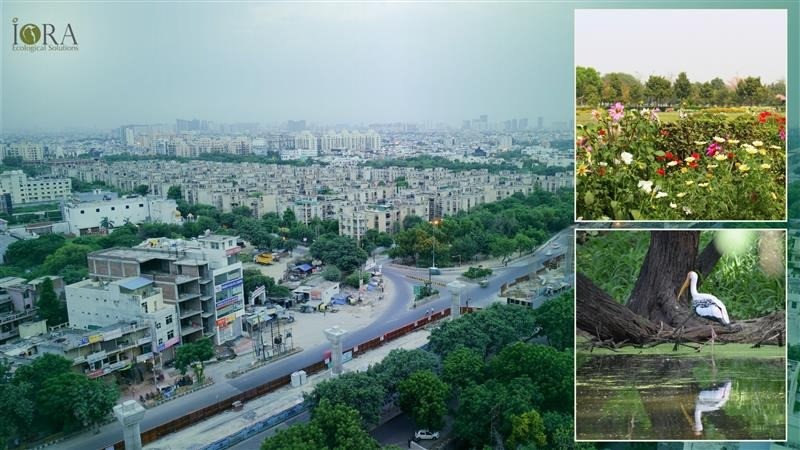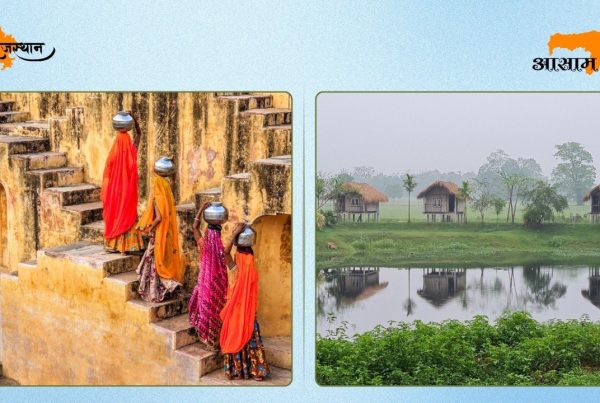Imagine a herd of wild elephants taking showers around Rohini, or a tiger waiting stealthily to attack a deer near Connaught Place. Its hard to believe today. But in the 17th century, French physician and traveller, Francois Bernier described Delhi exactly that. In his famous travelogue, Voyages en Inde, Bernier mentioned “The areas around the city was covered with wooded vegetation and filled with wild beasts, among them tiger and the elephants are the most prominent….the tiger is so common that it is not unusual to encounter one while on the outskirts of the city”.
During the same era, Ustad Mansur, the prominent artist and naturalist in the court of Jahangir, illustrated Delhi skies with various birds, showcasing the avian diversity of that of the time. Among his famous paintings, one is of the Siberian Crane, once the common winter migratory species in Delhi. Today the bird is critically endangered and nearly extinct in India, with no confirmed sightseeing since 2002-03 in Bharatpur, Rajasthan.
Exotic species are not considered as a part of local biodiversity, but we cannot help but mention that the now extinct bird, Dodo once appeared in the Mughal court, gifted to Jahangir and preserved forever through Mansur’s brush.

(Figure 1: [Left] Siberian Crane by Ustad Mansoor [Right] Dodo on the middle and Blue-crowned Hanging Parrot,Tragopan, Indian Goose, and Indian Sandgrouse by Ustad Mansoor)
When New Delhi grew as a city and became the capital of British India on 13th February, 1931, a shift began. Rapid urbanisation shrank the green cover and the city lost its old inhabitants. The Gharials, Indian Vulture, Long-billed Vulture, Jerdon’s Babbler, Indian Wolf could not sustain the concrete jungle, and the list goes on. Indigenous plants like Indian Frankincense or Salai guggal, Speargrass which were abundant once, also started disappearing.
But did we lose everything?
No, the nature has not vanished. Across Delhi, green blue spaces and surroundings, an expanding network of urban forests, biodiversity parks and restored wetlands still nurtures the biodiversity.
These green spaces are more than pretty patches of green on a planning map. Ecologically, they act as refuges for native plants and animals, stepping-stone corridors that allow species to move across an otherwise hostile matrix of concrete, and mini climate regulators that cool the infamous urban heat island. They also trap particulate pollution, recharge groundwater, reduce flood peaks during the monsoon and offer much-needed psychological respite for residents.
Delhi’s seven biodiversity parks alone—Yamuna, Aravalli, Kamla Nehru, Neela Hauz, Tilpath, Tughlaqabad and Kalindi Biodiversity park—spans roughly 3,000 acres and support hundreds of native plant species, over 300 bird species and at least 13 species of bats.
According to a report in the Indian Express, dated on 17th December, 2024, Wroughton’s free-tailed bat (Otomops wroughtoni) was spotted at the Delhi Development Authority (DDA)’s Yamuna Biodiversity Park. It is a highly rare species of molossus bat family. Another bat species Blyth’s Horseshoe bat (Rhinolophus lepidus) roost only in Aravalli Biodiversity Park in Delhi NCR. The location is among the remains of the Aravalli Hill Range, one of the oldest mountain range in the world, which stretches from Gujarat through Rajasthan to Haryana and Delhi and formed about 1500 million years ago. The ruins of the old city offer a suitable roosting site for the bats of Delhi. That is why abandoned monuments are perfect bat roosts. Bats are found in the relics of Hauz Khas and a Tughlaq-era mosque in Khirki extension; there are pictorial records of Mouse-tailed bats roosting inside the Firoz Shah Kotla mosque as well.

(Figure 2: [Left]Blyth’s Horsehoe Bat by Rohit Chakravarty, [Right] Lesser Mouse-tailed Bat by Telegro via Wikimedia Commons)
Once believed gone from the capital, the shy hog deer (Axis porcinus) has quietly reclaimed the Yamuna flood-plains—camera traps first caught it prowling through the Biodiversity Park in 2016, and eight individuals have been documented there since. The restoration of the Yamuna River’s active and inactive floodplains began in 2002 and continued until 2011, concluding in the creation of this Yamuna biodiversity park (YBP). YBP hosts our winter guests, Red-crested Pochard (Netta rufina), Eurasian Wigeon (Mareca penelope) and Ferruginous Pochard (Aythya nyroca). The first and third of the above mentioned guests comes from Central Asia and China, Kazakhstan, and Mongolia.

(Figure 3: Indian Hog Deer by Nejib Ahmed)
Few other spots to spot wildlife in and around Delhi are Asola Bhatti Wildlife Sanctuary and Sanjay Van. Asola Bhatti Wildlife Sanctuary is located at the southern Delhi ridge of the Aravalli hill range. Geographically this part of the ridge is 1.5 billion years old. The vegetation in the Wildlife Sanctuary is predominantly an open canopied thorny scrub. The native plants exhibit xerophytic adaptations such as thorny appendages, wax-coated, succulent and tomentose leaves. This sanctuary is the habitat of 193 bird species, 80 butterfly species, and almost 25 mammal species such as the Indian Crested porcupine, Black-naped Hare, Nilgai, Blackbuck, Large Indian Civet, Small Indian Civet, Golden Jackal and Jungle Cat found in Asola. According to recent camera trap probes, there are eight leopards and multiple hyenas using the forest region. The sanctuary covers an area of 32 sq kms however, keekar (Prosopis juliflora) have spread to arid, degraded locations as well as regions close to populated areas. Similarly, Sanjay Van, a part of South-Central Ridge has been notified as a reserved forest. This forest is home to more than 200 species of birds, 70+ butterflies, and many mammals such as Nilgai, Jackals, Hare, Porcupines along with snakes and numerous insects.
These green fragments do more than shelter biodiversity. They clean the air, store carbon, prevent flooding, and keep groundwater flowing. They make Delhi more liveable, especially as climate challenges intensify.
Yet their survival is not guaranteed. Invasive species like Prosopis juliflora and Lantana camara crowd out native shrubs, reducing nectar for butterflies and nesting sites for birds. , Simultaneously, urban expansion constantly encroach park boundaries, with bulldozers carving out roads, depots and high-rises. Evidence of this strain is clear: the 2025 Asian Waterbird Census recorded the lowest bird count ever at Najafgarh.
Still, change is possible. Policies are catching up with passion. The national Nagar Van scheme encourages cities to weave mini-forests into their fabric, while the DDA’s mandate now extends beyond landscaping to full ecological restoration—seed banking, soil profiling, hydrological engineering. Equally important, new Biodiversity Management Committees are giving resident colonies a legal voice in deciding how neighbourhood parks are planted and patrolled.
But, the future hinges on everyday choices: Consider a housing society that consciously invasive swaps Prosopis for native trees like jamun and dhak, or a metro corridor planted with butterfly-friendly native, non-invasive species and peepal saplings, eventually linking two forest patches. Each act, no matter how small, stitches another thread into Delhi’s fraying green quilt.
As World Biodiversity Day approaches, consider this invitation: Trade one hour of your weekend mall-run for a dawn walk in Yamuna Park, or help a local NGO replace pavements with pocket meadows. This very city, we must recall, once echoed with elephant trumpets. With our collective care, it can still resonate with warbler song and gecko chirrups. Delhi’s invisible wild is only invisible unless we choose to avert our gaze. Look closely, and you may find the future of urban nature taking wing just above the traffic, feathered pink and rising with the morning sun.

(Figure 4: Migratory birds in Najafgarh Jheel photo by India Today)
Suggested Readings:
- Bernier, F. (1916). Travels in the Mogul Empire, A.D. 1656–1668 (A. Constable, Trans. & Annot.; V. A. Smith, Rev. 2nd ed.). Humphrey Milford, Oxford University Press. (Original work published 1891)
- Mathew, S. (2024, December 17). Wroughton’s free-tailed bat, a highly rare species, spotted in Delhi’s Yamuna Biodiversity Park. The Indian Express. https://indianexpress.com/article/cities/delhi/wroughton-free-tailed-bat-rare-species-spotted-delhi-yamuna-biodiversity-park-9729664/
- Mishra, R., Dookia, S., Singh, M. K., Sultana, A., & Bhattacharya, P. (2018). Ecological and Acoustic-call Characteristics of Blyth’s Horseshoe bat, Rhinolophus Lepidus in Delhi,India. AMBIENT SCIENCE, 5(1). https://doi.org/10.21276/ambi.2018.05.1.ra02
- Mishra, R., & Dookia, S. (2015). Bats of Delhi. In Small Mammal Mail – Bi-Annual Newsletter of CCINSA & RISCINSA (No. 1; Vols. 7–7, pp. 15–17).
- Singh M, Gautam S, Srivastava DP, Jain P, Sirohi U, Singh H, Arjun, Khurana E, Khudsar FA. Hog deer Axis porcinus reclaiming historical geographical distribution range due to ecological restoration in the Yamuna Biodiversity Park, Delhi, India. Species 2023; 24: e84s1596
- “The flora of Dehli” by J. K. Maheshwari : J Sinclair : Internet Archive. (1966). https://archive.org/details/biostor-248336
- Champion, H. G., & Seth, S. K. (1968). A revised survey of the forest types of India. Manager of publications.
- Krishen, P., 2006. Trees of Delhi: A field guide. Penguin Books India.






